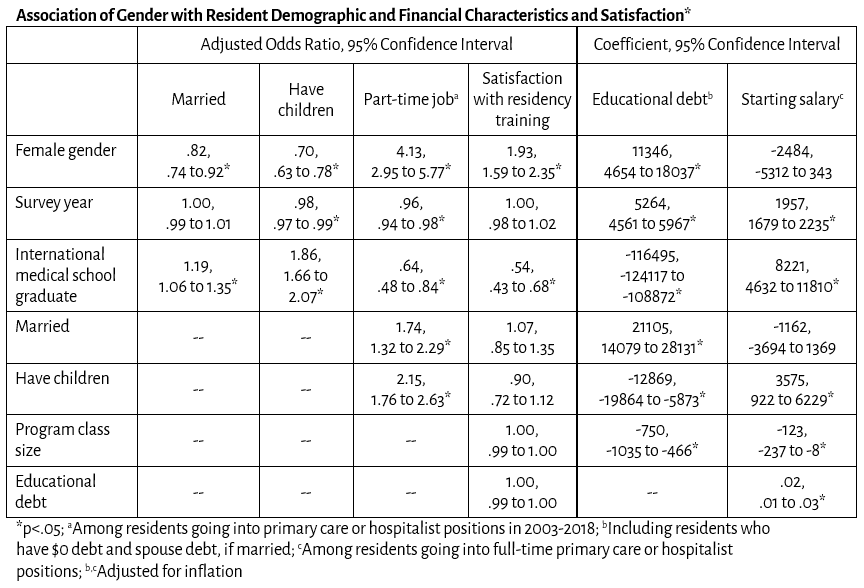Mary Pat Frintner1, William Cull1, Blake Sisk1, Daniel Schumacher2
1American Academy of Pediatrics, Itasca, IL. 2Cincinnati Children's Hospital Medical Center, Cincinnati, OH.
Presented at the 2019 Pediatric Academic Societies Annual Meeting.
Background: Approximately three-quarters of pediatric residents are women. Yet, little is known about how women and men compare on their family and financial characteristics and satisfaction with training.
Objective: Compare family characteristics, financial characteristics, and satisfaction of graduating pediatric residents by gender across time.
Methods: The AAP Annual Survey of Graduating Residents was sent to national, random samples of up to 1,000 graduating pediatric residents each year from 2003-2018; 58% completed the surveys (48-64% across years). Cross-sectional responses were pooled; chi-square tests and t-tests were used to examine the association of gender with a) family characteristics: married; have children, b) financial characteristics: educational debt (adjusted for inflation); part-time job; and starting salary (among residents going into full-time primary or hospitalist care jobs; adjusted for inflation), and c) satisfaction with residency training.
Multivariable logistic regression models examined the independent effect of gender on married and have children (controlling for survey year and international medical school graduate-IMG), part-time job (controlling for year, IMG, married, and children), and satisfaction with training (controlling for year, IMG, married, children, program size and educational debt). Ordinary least squares regression models estimated the adjusted difference in graduates’ debt and starting salary between men and women.
Results: Overall, 74% of residents in the sample were women, which was consistent across survey years, p=.23. Women were less likely than men to be married (69% vs 73%, p<.001) and have children (29% vs 38%, p<.001), respectively. They had higher educational debt (women: $162,645 vs men: $141,365, p<.001). Among residents starting primary care or hospitalist positions following residency, more women than men had part-time jobs (19% of women and 6% of men, p<.001), and full-time starting salaries were not significantly different (women: $147,369 vs men: $149,954, p=.08). Nearly all were satisfied with their training; 95% of women and 91% of men, p<.001.
All these bivariate relationships remained significant in the multivariable models [Table].
Conclusion: Starting salaries for residents entering primary care or hospitalist positions do not vary by gender. Men and women do vary on several other dimensions, including that women report more educational debt than men.

Last Updated
10/08/2021
Source
American Academy of Pediatrics